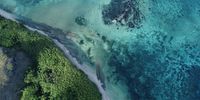Fiji is a Melanesian country in the South Pacific Ocean. It lies about two-thirds of the way from Hawaii to New Zealand and consists of an archipelago that includes 332 islands, a handful of which make up most of the land area, and approximately 110 of which are inhabited. Fiji straddles the 180 degree longitude line (which crosses land on a remote tip of Vanua Levu and again near the centre of Taveuni). The international date line is configured to pass east of all of Fiji, placing it all in one time zone and "ahead" of most of the rest of the world. Fiji is the product of volcanic mountains and warm tropical waters. Its majestic and ever-varied coral reefs today draw tourists from around the world, but were the nightmare of European mariners until well into the 19th century. As a result, Fijians have retained their land and often much of the noncommercial, sharing attitude of people who live in vast extended families with direct access to natural resources. When it came, European involvement and cession to Britain was marked by the conversion to Christianity, the cessation of brutal tribal warfare and cannibalism, and the immigration of a large number of indentured Indian laborers, who now represent nearly half of the population, as well as smaller numbers of Europeans and Asians. Today, Fiji is a land of tropical rainforests, coconut plantations, fine beaches, fire-cleared hills. For the casual tourist it is blessedly free of evils such as malaria, landmines, or terrorism that attend many similarly lovely places in the world. Internal political events in the recent past resulted in a reduction in tourism. The Fiji tourism industry has responded by lowering prices and increasing promotion of the main resort areas that are far removed from the politics in and around the capital, Suva.
Fiji Travel Guide
Top Destinations in Fiji

Matamanoa Island, Fiji
Matamanoa Island Resort has received a certificate of Excellence Award for 2012 from Trip Advisor. This award showcases the level of guest enjoyment as voted ... more
Vatulele, Fiji
Vatulele (pronounced [βatuˈlele]) is a coral and volcanic island 30 kilometers south of Viti Levu, Fiji's largest island. Situated at 18.50° South and 177.63° ... more

